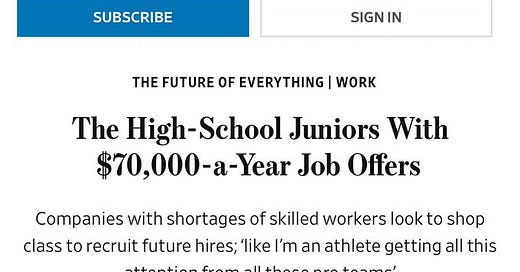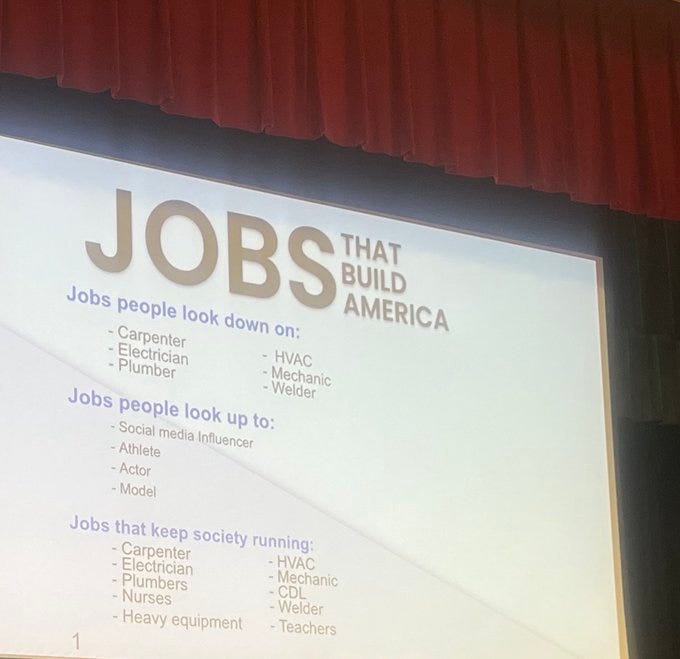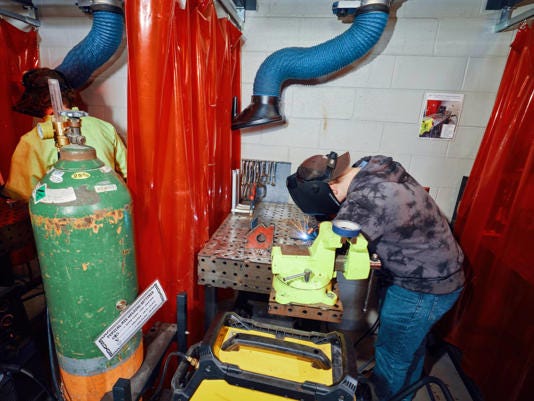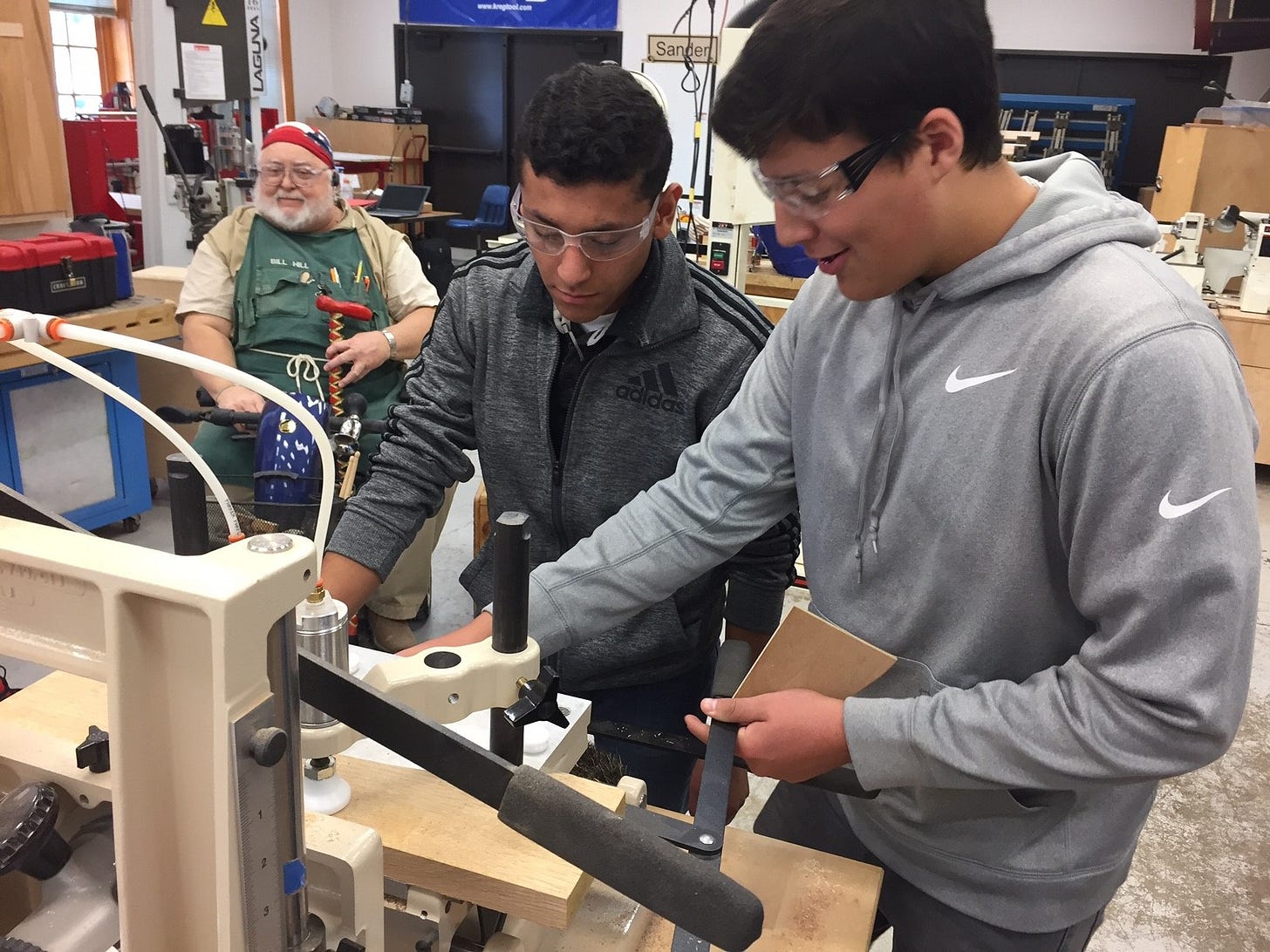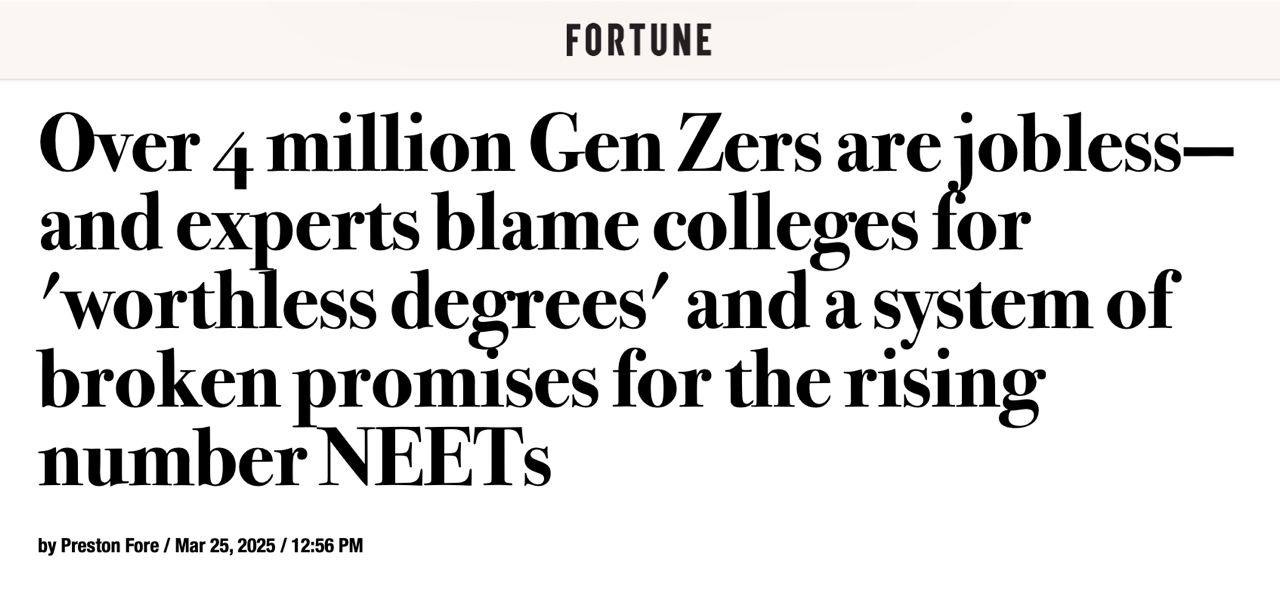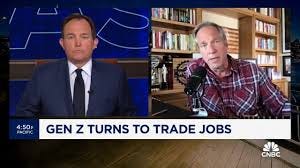Generation Z is increasingly opting out of college and entering the skilled trades, with many high schoolers securing jobs in these fields even before graduating.
Many of these jobs pay over $50,000 right out of high school, with some reaching into six figures just a few years out from leaving school. This comes as high schools across the nation in the past few years have begun to leave the ‘college-for-all’ path that has been pushed on students for decades. Parents and guidance counselors are also recognizing the value of trade careers, with many agreeing that learning a skilled trade can be a better pathway to economic security than going to college.
Trade schools require competency in critical thinking and problem-solving in the same way universities do.
CHARLIE KIRK: "High school juniors with shop class trade skills like welding and plumbing are getting job offers for $70,000 per year before they even graduate. No debt. No four year career delay. No indoctrination."
Young people may “look up” to social influencers, actors, athletes & models but the important jobs of the future will be the ones that rebuild America and keep it running.
This trend is driven by several factors, including the high cost of college education and the attractive salaries and job security offered by trades such as construction, plumbing, and automotive repair. Additionally, the shortage of skilled tradespeople is driving up demand and salaries, creating new opportunities.
Also, as the rise of artificial intelligence (AI) and other technologies continues to transform the workforce, schools are investing significant sums of money in vocational and trade-focused education to hedge against that.
WSJ: “School districts around the U.S. are spending tens of millions of dollars to expand and revamp high-school shop classes. With higher-education costs soaring and white-collar workers under threat by generative AI, the timing couldn’t be better.”
These schools are betting on the future of manual skills overlooked in the AI and digital age, offering vocational-education classes that school officials say give students a broader view of career prospects with or without college.
This investment in hands-on education is intended to serve as “a hedge against” the apparent inevitability of a future dominated by AI technology. Smart.
A high school near Madison, Wisconsin just completed a $90 million campus overhaul in 2022 that included new technical-education facilities. About a quarter of the school’s 2,300 students signed up for at least one of the courses in construction, manufacturing and woodworking.
Wood shop classes have been added to meet the demand of 175 students who enroll each semester, up 75 from four years ago.
Improvements at the school feature visible shop classes with fishbowl-style glass walls showcasing a modern manufacturing lab equipped with advanced tools like computer-controlled machines and robotic arms.
Andres Mendoza Alcala, a senior at Middleton High School aspiring to be a carpenter, stated: “I haven’t met a single person that looks down on someone else just because they’re doing the trades instead of college. They just say it’s a good choice. These are secure jobs.”
More younger workers are embracing blue-collar careers. The share of workers aged 20 to 24 in blue-collar jobs has grown by 10%. Enrollment in vocation-focused, two-year community colleges is growing double digits - outpacing by 5X the meager 3% increase at public four-year colleges.
As of 2025, the average student loan debt after leaving college is approximately $38,375 for federal loans and up to $41,618 when including private loans. The total outstanding student loan debt in the United States is $1.777 trillion, with 42.7 million student borrowers holding federal loan debt.
As of 2021, over 40 million student loan borrowers left college without completing a degree and roughly half of college graduates end up in jobs where degrees aren’t needed or in fields they did not study. Yet many high schools aren’t equipped to help students who want to skip college and learn a trade. Now that’s changing!
The average public trade school costs around $8,000 a year compared to average annual tuition of $30,000 per year at a 4-year liberal arts college.
TV host and skilled trades advocate Mike Rowe called Generation Z ‘the next toolbelt generation,’ emphasizing that many young people are choosing blue collar careers over bankruptcy from student loans.
Rowe has long advocated for vocational training and trade careers as a viable, and often more practical, alternative to four-year degrees.
Rowe explained: “They’re just saying, ‘Look, why do I want to start a career in a major I haven’t even declared yet and go that far into debt to pursue a job that probably doesn’t even exist, when we got 10,000 other jobs over here… that don’t require a four-year degree?
Plus, there are able-bodied men in their working ages not only not working, but not looking. That, to me, is one of the greatest alarm bells going on in the country. We've never seen that before, not in peacetime anyway."
The share of U.S.-born men aged 16 to 64 not participating in the labor force has nearly doubled over the last six decades, from 11.3% in 1960 to 22.1% in 2024.
In Gen Z (ages 13-28) - typical four-year college degrees are trending down. “There’s a lot more interest in electricians, and plumbers, and steamfitters, and welders and pipefitters."
17-year-old junior Elijah Rios has received a job offer for when he finishes school with Global Affinity, the Bristol, Pennsylvania-based manufacturer. The Catholic school student, who has been taking welding classes, will be paid $68,000 per year.
Father Judge, a Philadelphia Catholic school, works closely with companies seeking skilled trade workers, as those in the industry are facing a shortage of workers with baby boomers coming to retirement age. The welding classrooms at the school are frequented by employers such as local transit systems and submarine manufacturers to pitch their workplaces to students.
"Sometimes it’s a little overwhelming—like, this company wants you, that company wants you. It honestly feels like I’m an athlete getting all this attention from all these pro teams."
An increased focus on recruiting high schoolers has led to a resurgence in shop classes, and businesses are teaming up with schools to help students work part-time and earn credits and entrepreneurs are coming up with tools to help teens learn about their options.
Among those working to get younger workers into trades is Angie Simon, who served as the chief executive of a mechanical contractor in California until recently. She founded a summer camp where high schoolers can be exposed to careers in the trades. In the summer of 2025, her program will enroll 900 students at 51 locations across the country free of charge.
"I tell them, don’t call me for students when they graduate, grab them now when they’re 16 or 17, or I have nobody to work for you."
Studies show nearly 1 in 4 construction workers are older than 55. With retirement on the horizon for this group, it comes as no surprise that the construction industry continues to face a labor shortage and young people are needed to fill the gap.
Among those who have attended Angie’s summer camps is 18-year-old Jenny Cantrill, who now works at a plumbing and HVAC mechanical contractor. A fall 2024 open house at her high school attracted a record 1,000 people, and her classes all have a wait list.
I still say one of the best decisions that I ever made was NOT getting a college degree after high school and just working hard at whatever I did. Mike Rowe was right! A strong work ethic is crucial for success in any field. There is no substitute for hard work.
ROWE: "Work ethic is important because, unlike intelligence, athleticism, charisma, or any other natural attribute, it's a choice."
My work is free and supported by your generous donations. Thank you to all who have donated in the past. I truly appreciate your generosity!
If you like my work, you can fund me by becoming a paid subscriber on Substack, donate by credit card here or you can send me a check to Peggy Tierney, PO Box 242, Spooner, Wisconsin 54801- or just send me a note or a card! I love hearing from you.
